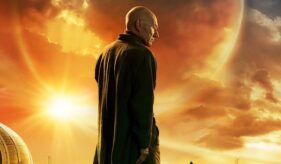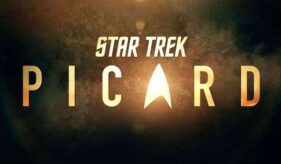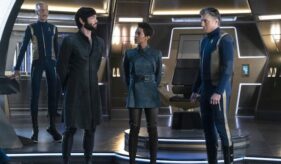TV Review: STAR TREK: PICARD: Season 1, Episode 1: Remembrance [CBS All Access]
Table of Contents
Star Trek Picard Remembrance Review
Star Trek: Picard: Season 1, Episode 1: Remembrance may be the beginning of the end of Star Trek on CBS All Access. Many would argue that the second season of Star Trek: Discovery was the beginning of the end but I would counter with Remembrance. Star Trek: Picard should be the flagship TV series for the streaming service, its calling-card like Stranger Things is for Netflix and The Handmaid’s Tale is for Hulu. Star Trek: Picard is nowhere close to that standard-bearer-quality. I heard about the behind-the-scenes turmoil regarding this TV series before it aired but I had hoped that it would not spill over onto the screen. It does, in a big way.
Show, Don’t Tell
The backstory on why Admiral Jean-Luc Picard (Patrick Stewart) left Starfleet, all of those key events, should be in the opening of this TV series. At the very least, it should be on-screen in someway. Remembrance‘s writers tell the viewer of these critical events instead of showing them to its audience.
Remembrance‘s writers don’t:
Show how the Synthetics revolt was quelled and by whom.
Show what the U.S.S. Enterprise did during this time period.
Show why the Romulan Empire couldn’t use its own ships to evacuate its people.
Show why the Romulan Empire, with its vast fortune, couldn’t rent or buy ships of all types to assist in the evacuation of its worlds.
Show Picard resigning.
TV is a visual medium. Remembrance‘s writers waste time telling the viewer about these important events during an interview, exposition dumping (a writing no-no), when they could be showing them to the viewer with a series of well-executed scenes. Star Trek: Deep Space Nine didn’t start off by telling the viewer that Commander Benjamin Sisko’s wife was killed in a Borg attack on his ship (led by Borg-ified Captain Jean-Luc Picard), they showed it.
The writers of Star Trek: Deep Space Nine showed what created Sisko’s animosity toward Picard.
In Remembrance, Star Trek: Picard’s writers tell the viewer about Picard’s animosity toward Star Fleet without showing what generated it.
When a series starts out with such big narrative missteps, I have no idea where it can go. Beside the brilliant first Data / Picard moment, the first episode of Star Trek: Deep Space Nine, Star Trek: The Next Generation, Star Trek: Enterprise, and Star Trek: Discovery are far superior to the first episode of Star Trek: Picard in almost every way.
The Episode’s Opening
The beginning of Remembrance is magnificent. The way it is shot has a movie feel to it, especially how Data (Brent Spiner) and Captain Picard are the only people in the room (is that supposed to be Ten Forward or some other room?). Their light-hearted banter is reminiscent of similar back and forth moments between the two characters on Star Trek: The Next Generation, with Data learning something new from his human compatriot. Unfortunately for the episode and the series, the scene’s ending reveals it to be a dream, a metaphor for the hopes the viewer brings with them into Remembrance that go unrealized.
The Unused Book Storyline
Like the Thrawn storyline in the Star Wars extended universe that went unused in the new Disney Star Wars trilogy, I can’t, for the life of me, understand why Star Trek producers didn’t use 75% of the storyline from Star Trek: Countdown for this TV series, especially since Star Trek: Picard and Star Trek: Countdown both follow the events in Star Trek: Nemesis.
The storyline in that four-part comic book series by Mike Johnson and Tim Jones is far superior and organic than what is on-screen in Remembrance. Granted, Remembrance is only the first episode but the harbingers it contains do not bold well for the series’ yet untold story.
The storyline for Data, Geordi La Forge, and Worf in Star Trek: Countdown alone make it superior to what is on-screen in Star Trek: Picard.
Data’s Non-Lal Offspring
The Lal storyline in The Offspring episode of Star Trek: The Next Generation was one of the most memorable story-lines in the series, especially how Data had secretly carried on with Dr. Noonien Soong’s cybernetic work.
In Remembrance, two new characters, identical twins cyborgs (Dahj and Soji Asha) are introduced, with the hope, I can only guess, of engendering a percentage of the residual Lal feelings from fans. They do not. Both cyborg characters are empty.
And their creation story, from what is in Remembrance, is haphazard at best – Commander Bruce Maddox gets banned from working on Synthetics so he builds a positronic brain and puts it in an organic body thus bypassing the ban on creating Synthetics.
Okay. Here are the questions that the screenplay doesn’t answer – Why does the viewer care? Why does anyone care about a Synthetic law bypass when the result is uninteresting?
Beaming Up Dahj instead of Repeatedly Attacking Her
If the Romulans want Dahj (Isa Briones) so badly, why do they keep beaming men down to attack her? Why don’t they beam her up on-board their ship (or to their base)? They obviously know exactly where she is.
The instant they beamed her up, it could be into a reinforced security room filled will knockout gas, thus they wouldn’t have to worry about her “activating” or killing any of their men.
Instead the Romulans keep beaming down personnel to engage in combat with a cyborg of far superior fighting ability. Why? To continuously create lackluster fight scenes and to be killed?
Romulans that Spit Acid
Romulans, an off-shoot of Vulcans, now have acid for blood, like xenomorphs? I look forward to how this is explained (though I doubt I will be watching this series long enough to find out). I am also looking forward to the explanation of why a Romulan with acid for blood would spit said blood at the target it is trying to capture alive and intact? It seems silly and falls right in line with other dubious plot shenanigans in this episode (I can’t believe they are saying that this is Star Trek. This is a B-movie err TV show.).
Killing the New Character Then Reversing It
The brief character building for Dahj in Remembrance, in the end, is pointless. She is killed at the end of the second act of Remembrance, a plot development to give Picard an emotional reason to keep going on his quest for answers. Seeing Dahj acid-burned, hearing her screams, provokes nothing in the viewer. The viewer does not know her and has no emotional attachment to her. If this death occurred after Dahj had been given depth, three-dimensionality, and most importantly, time, time to get to know her, then yes, her death (like Data’s death in Star Trek: Nemesis) may have had meaning. As it stands in the episode, Dahj’s death is a mere plot device to motivate the protagonist.
And then the episode reverses any nascent feelings the viewer has toward Dahj, following her death, by showing the viewer her identical twin alive and well. This, in effect, zeroes-out any type of emotional connection with Dahj (if any existed in the first place). If she, as a character, is disposal or interchangeable, what real purpose does she serve in the narrative besides as a motivator?
Leave your thoughts on this Star Trek Picard Remembrance review and these episodes of Star Trek: Picard below in the comments section. Readers seeking more TV show reviews can visit our TV Show Review Page, our TV Show Review Twitter Page, our TV Show Review Facebook Page, and our TV Show Review Pinterest Page. Want up-to-the-minute notification? FilmBook staff members publish articles by Email, Twitter, Facebook, Instagram, Tumblr, and Flipboard.
Related Articles
FilmBook's Newsletter
Subscribe to FilmBook’s Daily Newsletter for the latest news!













